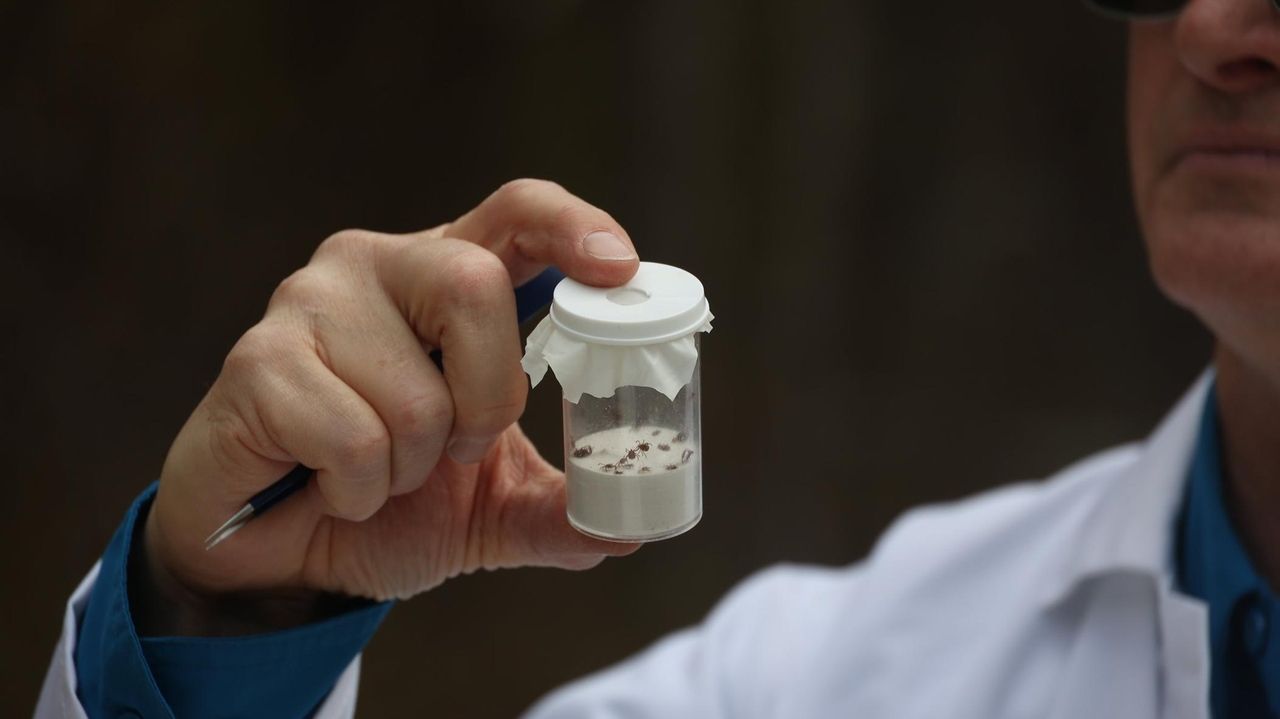Disease-carrying critters now a year-round problem

Summer on Long Island means sun, surf, sand and ticks.
Increasingly warm winters have made these voracious little creatures – which can carry many diseases – a year-round problem. But they get even friskier during the warm months. Experts are warning people, especially those visiting Long Island parks and beaches in the coming weeks, to take precautions.
Every year we learn more about ticks and the diseases they cause. Clinicians said treatment should be based on symptoms and a new Lyme disease surveillance criterion could create a more accurate baseline for cases. And Lyme disease testing isn’t always necessary.
Researchers are also learning that Black people may be diagnosed with Lyme disease at a much later stage because their symptoms, including the rash, are not always immediately recognized.
Anna-Marie Wellins, a doctor of nursing practice at Stony Brook Medicine, says education and prevention are the key to outsmarting ticks. Credit: Stony Brook Hospital, Southampton
“Ticks are very adaptive arthropods,” said Anna-Marie Wellins, a doctor of nursing practice who works at the regional tick-borne disease resource center at Stony Brook Southampton Hospital in Hampton Bays, which opened its doors last summer. “But we can outsmart them through education and prevention.”
Tick tracking
Long Island is one of the epicenters of Lyme disease and a hotbed for ticks. But instead of trying to determine the tick population in Nassau and Suffolk counties, scientists are focusing on finding pathogens carried by ticks that can cause diseases such as babesiosis, anaplasmosis , Powassan virus disease and a version of Rocky Mountain spotted fever, as well as Lyme disease. disease.
Wellins said that in general, about 20 percent of nymph (young) ticks carry some sort of pathogen, and 50 percent of adult ticks do.
The Suffolk County Health Department collects ticks from 10 different locations, one in each township, and conducts testing. In 2023, the majority of ticks tested positive for the bacteria that causes Lyme disease. Results ranged from 26% of adult ticks tested in Riverhead to 44% in Babylon, 50% in Smithtown and 70% in Shelter Island.
Nassau County does not conduct tick surveillance. But results from Tick Blitz 2023, a citizen science project run by the Northeast Regional Center of Excellence for Vector-Borne Diseases, led by Cornell University’s Department of Entomology, showed that most Ticks collected were blacklegged ticks and only in central and northern parts of Nassau.
“I have only been to Suffolk County once to look for ticks and found a variety of species and life stages,” said Jody Gangloff-Kaufmann, senior extension associate and entomologist for the Integrated Pest Management Program at Cornell University in New York. “Ticks are very active right now…Nassau County is no exception, although ticks tend to be found in the greener areas of the Mid-Island and to the north, in preserves and parks . »
Counting Lyme cases
Some experts believed for years that cases of Lyme disease were underreported because people didn’t have symptoms, didn’t seek treatment, or there wasn’t enough medical evidence to support a diagnosis. .
In 2022, the Centers for Disease Control and Prevention changed the way Lyme disease cases are reported, leading to a shocking increase in statistics. In 2022, 62,551 cases were reported to the CDC, compared to an annual average of 37,118 cases between 2017 and 2019.
A CDC study concluded that this increase was due to the reporting change and not an increase in disease risk.
“In our areas and others where the incidence of Lyme disease is higher, they will now base their estimates on the number of positive lab results,” said Dr. Andrew Handel, a pediatric infectious disease expert at Stony Brook Children’s Hospital, which treats patients with this disease. tick-borne diseases. “But once you test positive for Lyme disease, you can test positive for years, so doing it solely based on lab tests doesn’t always tell you if someone actually has Lyme disease .”
Dr. Andrew Handel, a pediatric infectious disease expert at Stony Brook Children’s Hospital, treats patients with tick-borne illnesses. Credit: Randee Daddona
Handel said that if a person is bitten by a tick but does not have symptoms such as a target-shaped rash, fever, joint pain, fatigue and brain fog, they do not have necessarily need to be tested.
“A lot of parents come in and really want their kids to be tested for Lyme disease after every tick bite,” he said. “It’s a difficult situation because I understand the need to make sure they don’t have Lyme disease, but it can open the door to a lot of confusion. It is common to have these antibodies, but you may not be sick or have an infection.
Tests also can only be done about two or three weeks after a bite because they look for antibodies, not the bacteria that causes Lyme disease.
Instead, Handel said people should focus on the rash that accompanies a bite and the immediate or developing symptoms. In some cases, people who are bitten will be given a dose of antibiotic as a preventative measure while continuing to monitor for symptoms.
A late diagnosis
Researchers are finding that it takes longer for people with darker skin to be diagnosed with Lyme disease. A recent study from the Johns Hopkins Medicine Lyme Disease Research Center shows that black patients were more likely to have advanced stages of Lyme disease and experience delays in getting antibiotic treatment.
Researchers said there was a lack of awareness among the community and doctors. Additionally, the way rashes appear on darker skin is less likely to be seen in textbooks.
A later diagnosis could mean people develop more serious symptoms, including severe fatigue and an irregular heartbeat. “They are underdiagnosed and early cases go undetected,” Handel said. “It’s a real problem.”
He said he was working with hospital staff to conduct an investigation to focus on the issue.
Ticks to watch out for
Gangloff-Kaufmann said the spread of invasive Asian longhorned ticks, which have been found on pets, livestock, wildlife and humans, continues on Long Island since they were first discovered in the United States. -United in 2017.
The CDC said a study found that this tick is not likely to spread Lyme disease, but research is ongoing. Another study found that it can spread the bacteria that causes Rocky Mountain spotted fever.
Female ticks can lay eggs and produce more female ticks without mating.
“This allows these ticks to quickly develop large populations wherever they find hosts,” Gangloff-Kaufmann said, including deer, opossums and raccoons. “They don’t like people, but we have to be mindful of our pets and make sure they are protected.”
The Gulf Coast tick has also made its way to Long Island from the southeastern United States. It can transmit a form of spotted fever to humans, according to the CDC.
“We don’t know exactly what their consequences will be,” Gangloff-Kaufmann said.
How to avoid ticks
- Check yourself every day. Ticks appear in skin folds, such as under the arms, behind the knees, inside the belly button, and around the waist. Children should also be carefully monitored.
- When you go out, pull socks up over pant legs and tuck in shirts. Wearing light-colored clothing can help spot ticks. Use insect repellent but be sure to follow the product’s instructions.
- Shower as early as possible after being outside. Throw clothes in a hot dryer before washing.
- Talk to your veterinarian on protecting dogs and cats with treatments.
What to do if bitten by a tick
- Use tweezers to remove the tick by grabbing its head. You may want to keep the tick in a small container or bag for identification purposes.
- Use rubbing alcohol or soap and water to disinfect the tick bite area.
- Monitor your health and contact your doctor if you develop a rash, fever, pain, fatigue, or swollen joints.
SOURCE: Stony Brook Hospital Southampton Regional Tick-Borne Disease Resource Center
News Source : www.newsday.com
Gn Health





